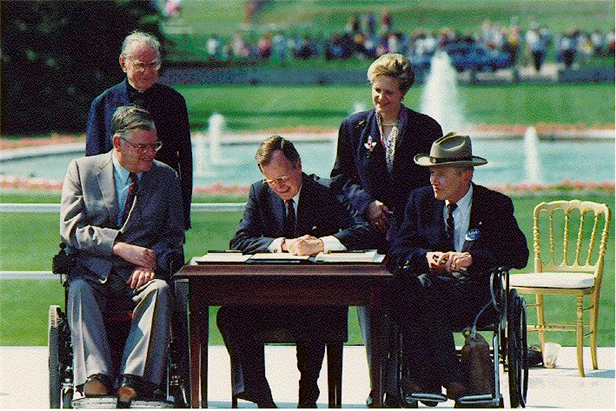With the 30th anniversary of the signing of the ADA being celebrated today, it makes sense to reflect on how reasonable accommodations ensured by the ADA have improved the lives of people with disabilities and how we can continue moving forward to make a more accessible and inclusive future for everyone.

The ADA was signed into law on July 26th, 1990 by, then president, George H. W. Bush. Since then, the ADA has been utilized to protect the civil rights of people with disabilities. Much like the first disability civil rights law, Section 504.
The legislation has 5 sections, referred to as titles, which address specific protections for Americans with disabilities.
Title I – Equal access to employment.
This title protects the right to reasonable accommodations such as, accessible work spaces, remote work, adjustable work schedules, access to interpreters, access to software, such JAWS screen reader (JAWS Software in NATADS Inventory Website), and modifications or additions to equipment such as a HeadMouse (HeadMouse in the NATADS Inventory Website) .
Title II – Equal access to services, programs, and activities provided by state and local government entities.
This title ensures that everyone has access to otherwise inaccessible historical buildings via ramp, audible crosswalk signals, accessible play areas in public parks, and government websites.
Title III – Equal access to public spaces .
This title requires that structures like grocery stores, medical buildings or privately owned transportation systems existing prior to the enacting of the ADA are made accessible, within reason, and that new construction meet established accessibility standards; this has also come to include virtual spaces of eCommerce. This is best seen in spaces like, amusement parks structuring rides to enable wheelchair users to easily transfer, Microsoft PowerPoint providing auto captioning, student disability centers at private universities, and food ordering apps being compatible with phone accessibility features.
Title IV – Equal access to telecommunications.
Companies who offer telephone service to the general public must also provide telephone relay services to individuals who use telecommunication devices for the deaf (TTYs) or other assistive technology. This title ensured that users have: 24 hour access, pay equivalent prices to non-users, unlimited call time, a right to accurate translation and a right to confidentiality.
Title V – Miscellaneous
With Title V addressing miscellaneous concerns, it could be easy to miss that one of the most important elements of the ADA is contained in this title. That being, the prohibition of retaliation against individuals with disabilities, or those attempting to aid people with disabilities, for asserting their rights under the ADA. This provision is key to people with disabilities participating in the enforcement of their civil rights under the ADA.
Looking forward…
The ADA has paved the way for many and will continue to do so for decades to come. In the future we must advocate and educate to create further positive change in a number or areas. Here are a few of what we consider to be priorities.
- People with disabilities still suffer a higher mortality rate in the event of an emergency. We need to be included in emergency services development across the nation. See CFILC’s DDAR program page to learn about strategies being implemented in California.
- The disability community needs to be at the table for climate change discussions, ensuring that there is equity in climate justice and that disability rights and access are not forgotten.
- There needs to be access to affordable universally designed housing (accessible showers, ramps and stair lifts).
- The rights of community members being detained by the police must be protected, by way of safeguards like disability competence training or handcuff accommodations for community members who use sign language.
- The challenges of enforcing the ADA must be addressed, the onus of reporting violations should not fall solely on disabled people.
- We need to develop incentives for accessible and affordable autonomous vehicles that will increase independence and employment opportunity for people with physical, intellectual and a whole range of additional disabilities.
How to get involved!
- Get counted! If you have not completed your census survey, please do. It’s one way to ensure that Californians get the funding needed to increase programs and services that we all benefit from.
- Vote! You have the ability to put people in power who care about disability and issues that are relevant to our well being.
- Run for office yourself or encourage someone you know with a disability to get engaged. We need disabled people in leadership positions at all levels.
- Get involved! Connect with your local Independent Living Center and join their community organizing activities and events.
- Celebrate! – be vocal about the strengths and values people with disabilities bring to the table .
- Embrace disability intersectionality – recognize that disability is everywhere, regardless of age, gender identity, race, sexual orientation, immigration status, disability type or if you are multiply marginalized. We are always more powerful when we work and create space for each other together.




